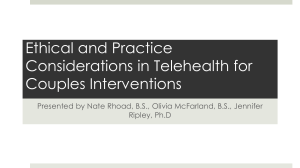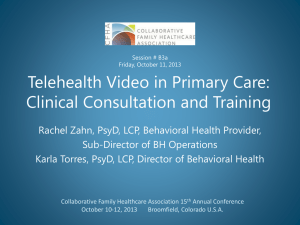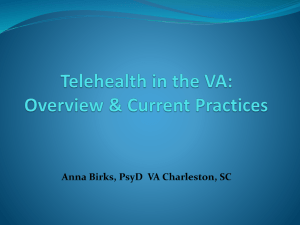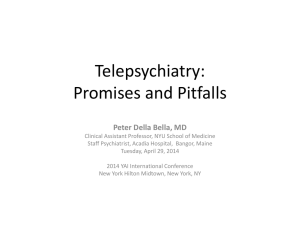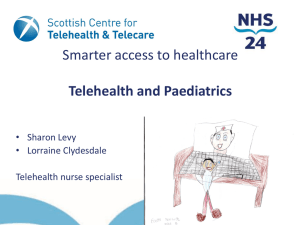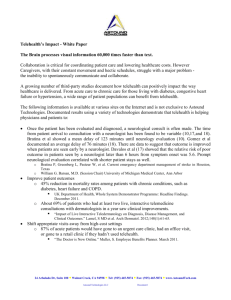6 Optimization Strategies for Telehealth and Home
advertisement
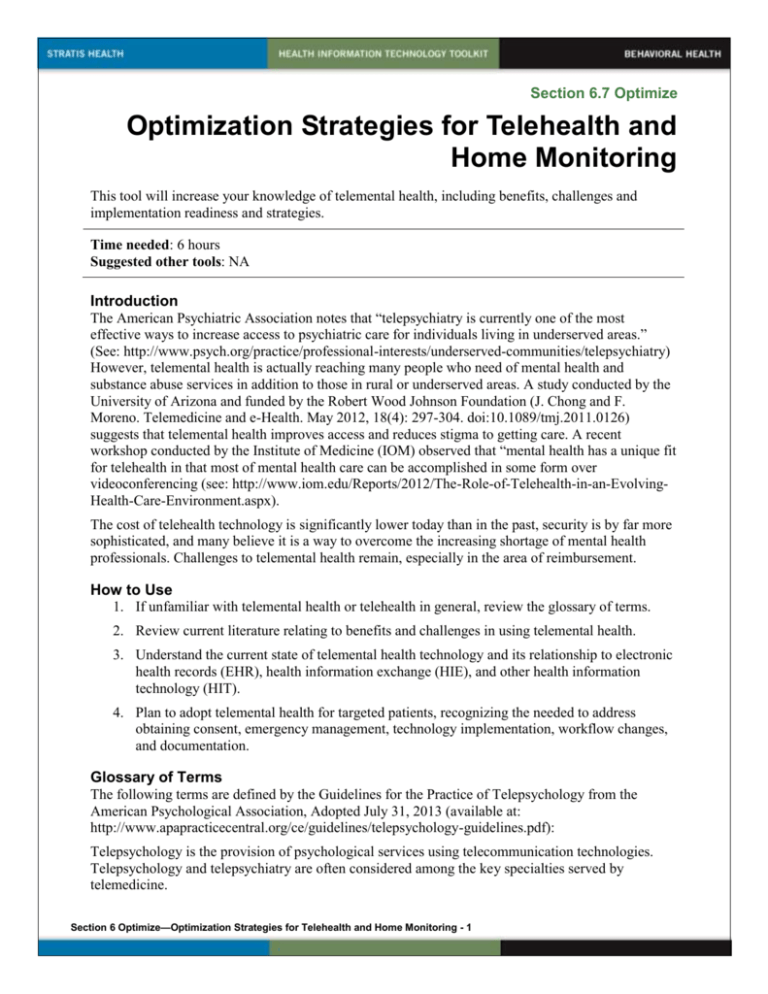
Section 6.7 Optimize Optimization Strategies for Telehealth and Home Monitoring This tool will increase your knowledge of telemental health, including benefits, challenges and implementation readiness and strategies. Time needed: 6 hours Suggested other tools: NA Introduction The American Psychiatric Association notes that “telepsychiatry is currently one of the most effective ways to increase access to psychiatric care for individuals living in underserved areas.” (See: http://www.psych.org/practice/professional-interests/underserved-communities/telepsychiatry) However, telemental health is actually reaching many people who need of mental health and substance abuse services in addition to those in rural or underserved areas. A study conducted by the University of Arizona and funded by the Robert Wood Johnson Foundation (J. Chong and F. Moreno. Telemedicine and e-Health. May 2012, 18(4): 297-304. doi:10.1089/tmj.2011.0126) suggests that telemental health improves access and reduces stigma to getting care. A recent workshop conducted by the Institute of Medicine (IOM) observed that “mental health has a unique fit for telehealth in that most of mental health care can be accomplished in some form over videoconferencing (see: http://www.iom.edu/Reports/2012/The-Role-of-Telehealth-in-an-EvolvingHealth-Care-Environment.aspx). The cost of telehealth technology is significantly lower today than in the past, security is by far more sophisticated, and many believe it is a way to overcome the increasing shortage of mental health professionals. Challenges to telemental health remain, especially in the area of reimbursement. How to Use 1. If unfamiliar with telemental health or telehealth in general, review the glossary of terms. 2. Review current literature relating to benefits and challenges in using telemental health. 3. Understand the current state of telemental health technology and its relationship to electronic health records (EHR), health information exchange (HIE), and other health information technology (HIT). 4. Plan to adopt telemental health for targeted patients, recognizing the needed to address obtaining consent, emergency management, technology implementation, workflow changes, and documentation. Glossary of Terms The following terms are defined by the Guidelines for the Practice of Telepsychology from the American Psychological Association, Adopted July 31, 2013 (available at: http://www.apapracticecentral.org/ce/guidelines/telepsychology-guidelines.pdf): Telepsychology is the provision of psychological services using telecommunication technologies. Telepsychology and telepsychiatry are often considered among the key specialties served by telemedicine. Section 6 Optimize—Optimization Strategies for Telehealth and Home Monitoring - 1 Telehealth reflects the broadest scope of providing therapeutic services, triage, monitoring, and mentoring. It is within this context that the term telemental health has been derived, sometimes also called e-therapy. Telecommunications technologies, which may be used in various combinations including to augment in-person therapy, include but are not limited to telephone, mobile devices, interactive videoconferencing, email, chat, text, and Internet (e.g., self-help Web sites, blogs, and social media). Also defined by the American Telemedicine Association (ATA) is the term telematics – which refers to the use of information processing, based on a computer in telecommunications, and the use of telecommunications to permit computers to transfer programs and data to one another. The interoperability of telecommunications with EHR, use of HIE, and other HIT, as well as clinical monitoring devices (e.g., automated blood pressure cuffs, scales, etc.), is becoming increasingly important in health care. Benefits and Challenges in Telemental Health Benefits The American Psychiatric Association website, psych.org, identifies the following benefits: Capability to provide an array of services, including but not limited to diagnosis and assessment, medication management, and individual and group therapy. Opportunity for consultative services between psychiatrists, primary care physicians and other health care providers. Pediatricians have been found to be especially receptive to telepsychiatry. One psychiatrist who works for Youth Health Services in Elkin, West Virginia, finds that children with anxiety disorders become more animated when they see him on television (see: http://www.computerworld.com/s/article/print/9224091/Web_based_counseling_Telepsychia try_is_taking_off?taxonomyName=Healthcare+IT&taxonomyId=132). Provision of second opinions in areas where only one psychiatrist is available. Improvement in collaborative services between professionals. Studies indicate that health care professionals feel telepsychiatry gives them an opportunity to work more effectively as a team. Patients surveyed say they feel communication between their physicians had improved their outcomes. Additional benefits include: Ability for police and fire departments and case managers to use lightweight, accessible, and affordable telehealth technology to connect to mental health professionals anywhere patients may be, including emergency departments, rural health clinics, nursing homes, their own homes, homeless shelters, schools, correctional facilities, and cruise ships. Overcoming the shortage of trained mental health professionals. (See iHealthBeat for recent statistics, at: http://www.ihealthbeat.org/insight/2013/telepsychiatry-poised-to-take-off-butobstacles-remain). Reduction in in-patient visits (by as much as 25 percent) has been cited by the Department of Veterans Affairs and the Department of Defense, which were early adopters of telehealth for mental health care for soldiers and veterans. In response to needs and requests of mental health providers and organizations, the ATA formed a committee to develop evidence-based telemental health guidelines, which were published in July 2009 (see: http://www.americantelemed.org/docs/defaultSection 6 Optimize—Optimization Strategies for Telehealth and Home Monitoring - 2 source/standards/evidence-based-practice-for-telemental-health.pdf?sfvrsn=4). An extensive literature review was included in these guidelines. Barriers There are barriers and challenges to providing telepsychiatry services: Reimbursement is most often cited as the biggest barrier. o Medicare reimburses for telepsychiatry at the same rate as face-to-face treatment, but the consumer must be located in a non-metropolitan statistical area, treated in a qualifying facility, accompanied by a qualified staff person, and provided an approved procedure. See the following for a summary additional information: http://www.securetelehealth.com/medicare-reimbursement.html; o http://www.americantelemed.org/docs/default-source/policy/medicare-payment-oftelemedicine-and-telehealth-services.pdf?sfvrsn=14 o Medicaid reimbursement varies by state, with only 40 states reimbursing for the encounter and supervision on the client side. See the following for a summary of additional information: http://www.securetelehealth.com/medicaidreimbursement.html o Commercial payers are also starting to provide reimbursement at the same rate as face-to-face treatment. The American Psychiatric Association maintains a Private Payer Reimbursement Information Directory (see: http://www.psychiatry.org/practice/professional-interests/underservedcommunities/telepsychiatry-internet-resources) There is no national licensing system, so mental health professionals can only treat patients in states where they hold a license. Ubiquity of technology is necessary. Clients cannot be expected to travel to a clinic to log onto a webcam. However, the digital divide has significantly lessened, with many more Americans having smart phones and accessibility to computers with broadband connectivity. Free phone service through the Internet, such as Skype, also improves access. However, reimbursement mechanisms typically require supervision on the client side, so the technology alone is not the answer. An article by Stacie Deslich, “Telepsychiatry in the 21st Century: Transforming Healthcare with Technology” in the summer 2013 issue of Perspectives in Health Information Management cites patient safety, security, and confidentiality as important challenges (see http://www.ncbi.nlm.nih.gov/pmc/articles/PMC3709879/). This article notes that during consultations, providers and patients engage in a great deal of nonverbal communication. Although much research supports the use of telepsychiatry as being equivalent to face-to-face treatment, it is important to be aware of any potential differences with telepsychiatry that would decrease the perceived value of the interaction or otherwise put the patient at risk for self-harm. Confidentiality and security remain concerns, although this article also suggests that the improper storage of transcribed paper documents is as great a risk as the improper storage of video or voice recordings. As with all use of EHR and HIE, proper physical and technical security controls must be in place to assure the confidentiality of the session and the documentation. In late 2012, the Institute of Medicine (IOM) published The Role of Telehealth in an Evolving Health Care Environment (available at: http://www.iom.edu/Reports/2012/The-Role-of-Telehealth-in-anEvolving-Health-Care-Environment.aspx). It identified some additional technical challenges: Section 6 Optimize—Optimization Strategies for Telehealth and Home Monitoring - 3 Using off-the-shelf devices, such as mobile phones, gaming systems, social media, etc. to connect to providers is rapidly becoming feasible, but to connect with EHRs and participate in HIE, these devices should be compliant with health care interoperability standards, such as Health Level Seven (HL7) Data Communications Protocol. Managing data flowing in from all the devices and presenting the information to providers in a meaningful and actionable way. Lack of broadband connectivity in some rural and underserved population areas. (See the Federal Communications Commission Eighth Broadband Progress Report, June 2011, available at: http://www.fcc.gov/reports/eighth-broadband-progress-report). Telemental Technology The following terms are defined by the American Telemedicine Association in its Practice Guidelines for Videoconferencing-Based Telemental Health (available at: http://www.americantelemed.org/docs/default-source/standards/home-telehealth-clinicalguidelines.pdf?sfvrsn=2). These are in addition to the terms discussed in Section 1.3 Interoperability for EHR and HIE. Asynchronous means that transmission of information occurs in one direction at a time. Asynchronous transmission is used in the telehealth encounter type called Store and Forward (S&F). Bandwidth is a measure of the information carrying capacity of a communications channel that is a practical limitation with respect to size of images that can be communicated, cost, and capability of telehealth services. Broadband refers to communications (e.g., broadcast television, microwave, and satellite) capable of simultaneously transmitting several messages. CODEC is an acronym for coder-decoder and is the capability of converting analog video and audio signals into digital video and audio code – essential for transmission of data and its storage (such as in an EHR). Data compression refers to the ability to reduce the volume of data to smaller packets that can facilitate data transmission. Technical standards exist for various types of data compression. Document camera is one that can display written or typed information, photographs, graphics, and— in some cases—x-rays. Fiber optic cables transmit data, voice, Internet access, and video with speeds in excess of 100 megabits per second (Mbps) [for comparison, see “plain old telephone system” (POTS) and Trunk or Digital Subscriber Lines]; the services are very expensive and are usually used either by the telephone company itself to support other services, or local campus connectivity. Integrated Services Digital Network (ISDN) is a common dial-up transmission path for interactive video (ITV). Per minute charges accumulate at a contracted rate and are billed to the site placing the call. Interactive video/television is analogous with video conferencing technologies that allow for twoway, synchronous, interactive video and audio signals for delivering telehealth. It is often abbreviated ITV, IATV, or VTC (video teleconferencing). Plain old telephone system (POTS) is a telephone service providing voice and data transmission at speeds of 33 to 64 kilobits per second (Kbps). Section 6 Optimize—Optimization Strategies for Telehealth and Home Monitoring - 4 Synchronous means transmission of information can occur in both directions at the same time, supporting interactive video connections. Synchronous transmission is used in the telehealth encounter or consult type called Real Time. Trunk or Digital Subscriber Lines from the telephone company offer high-speed data, voice, or compressed video access in two directions. T1/DS1 has a transmission rate of 1.544 Mbps and T3/DS3 has much faster (and costlier) service speeds of 45 Mbps. Telematics refers to the use of information processing based on a computer (e.g., EHR) in telecommunications, and the use of telecommunications to permit computers to transfer programs and data to one another. Universal Service Administration Company (USAC) administers the Universal Service Fund, which provides affordable health, education and other telecommunication services to rural facilities and others. Videoconferencing is the two-way transmission of digitized video images between multiple locations. WiFi is the name of wireless networking technology that uses radio waves to provide wireless highspeed Internet and network connections. Implementing Telemental Health Just as with EHR and HIE, in planning to adopt telemental health technology, it is important to apply a process that includes: a readiness assessment of both the behavioral health facility and each person to whom telemental health services are offered; optimal selection of equipment; proper implementation; attention to workflow changes; and assurance of necessary documentation. Readiness Assessment An assessment of the organization’s standard operating procedures and protocols, professionals’ readiness to perform e-therapy effectively, and other assessments includes: Standard operating procedures and protocols. Practice Guidelines for VideoconferencingBased Telemental Health published by ATA suggest that there be an assessment of the organization and provider that assures: o Agreements are in place with respect to licensing, credentialing, training, and authentication of patients and practitioners as appropriate according to local, state, and national requirements. o Billing and coding processes are in compliance with requirements and sharing them with third party payers does not risk exposure of mental health patients’ protected health information. o Privacy and security practices of the organization and providers address the higher standard of rights afforded mental health patients and documentation of services provided to them. o Appropriate policies and procedures are in place for all administrative, clinical, and technical components of telemental health services. o A systematic quality improvement and performance management process exists that complies with organizational, regulatory, or accrediting Section 6 Optimize—Optimization Strategies for Telehealth and Home Monitoring - 5 requirements. This process is used to evaluate the provision of telemental health services and make any necessary programmatic and clinical changes. o Consents for treatment are in place as needed. There are no special consents needed to use telemental health, but there should be the ability to obtain and appropriately share consents for any treatment that requires them. Assessment of the skills of behavioral health professionals have to effectively carry out telemental health, perhaps including: o Ability to determine which cases are suitable for telemental health services. o Cultural competency in the population being served at a distance. o Good listening skills (e.g., discovering details in patient conversation, interrupting patient only if necessary) o Effective interviewing techniques (e.g., asking open-ended questions, active listening, motivating) o Ability to detect emotional cues via the phone (e.g., crying, dyspnea, silence) that may call for modifications or even discontinuation of telemental health service Availability of supporting documentation technology, such as EHR—to document telemental health encounters in a timely, accurate, and complete and receive and use data feeds. Availability of supporting HIE technology, such as using the Direct protocol for secure email and/or participating in an HIE organization (HIO). Selection and Implementation Considerations To select the right equipment, consider the following features (in addition to those relating to terms defined above and to those described in Section 2.9 Requirements Analysis and Prioritization for EHR and HIE: Vendor-related considerations o Minimum number of units to acquire o Monitoring service offered o Equipment obsolescence o Cloud-based storage Product-related considerations o HL7 compliant o Size/weight for portability o Backup battery and/or operational batteries o Video quality, if applicable o Sound quality, if applicable o Clinical peripherals, if any FDA approved Vendor flexibility o Security controls meet HIPAA requirements Facility-side ease of implementation o Integration with EHR o Connectivity to HIE services used o Special equipment (e.g., cameras, connectivity) setup o Digital picture download Client-side ease of implementation o “Plug and play” devices that fit standard computers (and telephones, especially for mobile telemental health) o Need for routers, (internal/external) modems, and other peripheral devices Section 6 Optimize—Optimization Strategies for Telehealth and Home Monitoring - 6 o Number of peripheral devices that can function at one time (i.e., how many serial ports) o Digital picture upload Facility-side ease of use o Ability to transmit, retrieve, and store data o Ability to generate clinical, productivity, and usage (e.g., telephone charges) reports o Programmability for unique patient needs Client-side ease of use o Equipment reliability o Sanitation and safety factors Workflow Changes There may be workflow changes that need to occur as telemental health services are performed. For example: All persons present at both sites should be identified to all participants prior to the service being performed. Sharing of clinical history, consents, and other information should occur prior to and/or concurrent with the telemental health session. There should be a traceable record of the session at both the referring and consulting sites. It is recommended that this be in the form of a consultation report that is generated through standard dictation/transcription or via templates offered through an EHR. While audio and video recordings may be retained, these do not serve as formal session documentation. If psychotherapy is performed, special considerations such as those provided through the HIPAA Privacy Rule must be addressed. Expert pharmacotherapy workflow must be studied and codified in a procedure that is precisely followed. Special considerations must be given to how medical emergencies occurring during a session will be handled, how children and the elderly will be accommodated, additional requirements of rural or underserved populations, and community resources available for substance abuse assessment and treatment. Copyright © 2014 Stratis Health. Section 6 Optimize—Optimization Strategies for Telehealth and Home Monitoring - 7 Updated 01-01-14
